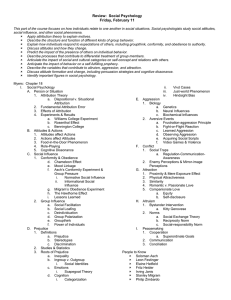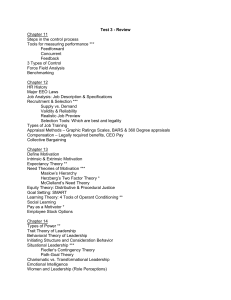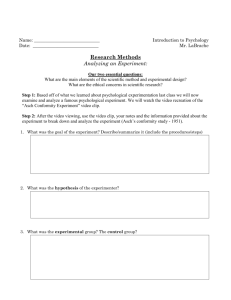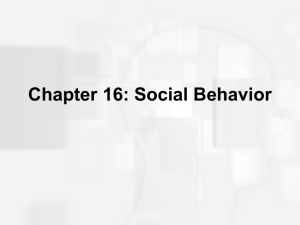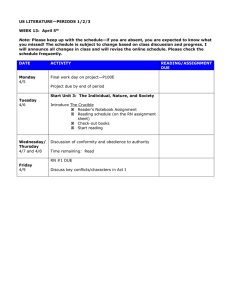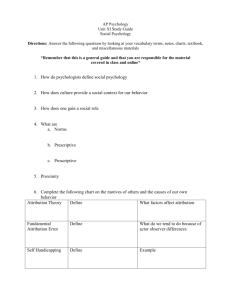Chapter 15 Mini Unit on Social Behavior
advertisement
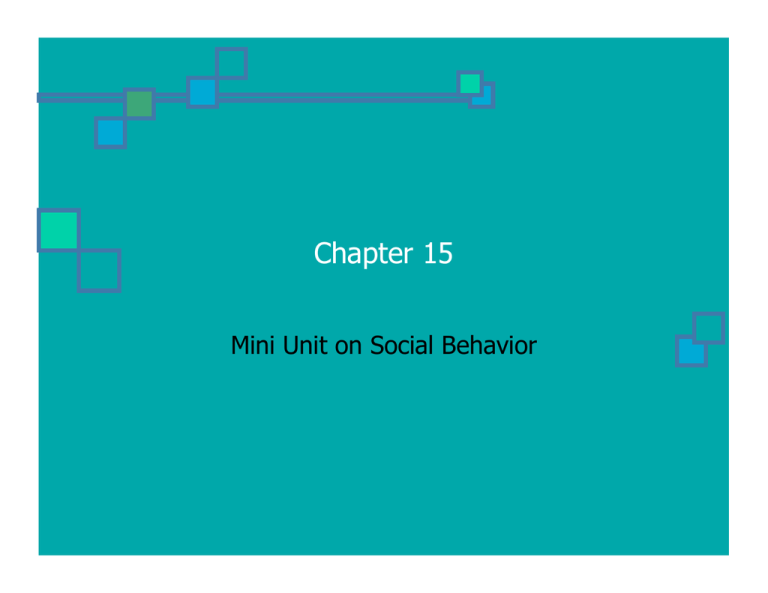
Chapter 15 Mini Unit on Social Behavior Social Psychology Attribution processes Schemes (schemas) Attitudes Conformity and obedience Behavior in groups How are attitudes formed? A Genetics B Family beliefs C. School D. Television Attribution Processes: Explaining Behavior Social roles- patterns of behavior expected of persons in various positions defines how those in the position ought to behave Ascribed- assigned (e.g. son, inmate) Achieved – teacher, Group formation and bias Zimbardo Prison Study Social Roles – internalizing social roles People may obey or take on assigned roles – under various conditions What is ideology? Examples of social and institutional support for carrying out oppressive actions. Conformity and Obedience: Yielding to Others Conformity – Solomon Asch (1950s) Classic experiment Group size Group unanimity Social Influence Asch’s conformity experiments Figure 18.2 Types of Stimulus Lines Used in Experiments by Asch Asch, S. E. (1955). Opinions and social pressure. Scientific American, 193, 31-35 Social Influence 50% Difficult judgments 40 Percentage of 30 conformity to confederates’ 20 wrong answers 10 0 Conformity highest on important judgments Easy judgments Low High Importance Participants judged which person in Slide 2 was the same as the person in Slide 1 Conformity and Compliance Conformity: Person changes behavior or beliefs to match other members of the group Occurs as the result of unspoken group pressure, real or imagined Compliance: Person adjusts his or her behavior because of a request Asch’s study of conformity to an incorrect norm (1956) Which is the best example of compliance? A. Employer Nazi Germany; asks employees to wear Jewish Stars if Jewish B. All the kids in your class make fun of Suzy and you join in. C. Your friends get their hair dyed with a purple streak; you do also. Yielding to Others: Obedience Obedience – Stanley Milgram (1960s) “I was just following orders” Controversial landmark experiment Teacher/Learner 65% administered all levels of shock Pressure from authority figures Milgram’s Obedience Study Factors that lead to obedience Legitimacy/closeness of authority figure Remoteness of victim Assignment of responsibility Modeling Social Psychology- Social Roles Attributions Internal vs. External Bias in attribution Fundamental attribution error Self-serving bias Cultural influences Social Thinking Fundamental Attribution Error tendency for observers, when analyzing another’s behavior, to underestimate the impact of the situation and to overestimate the impact of personal disposition Attitude belief and feeling that predisposes one to respond in a particular way to objects, people and events Social Thinking Foot-in-the-Door Phenomenon tendency for people who have first agreed to a small request to comply later with a larger request Attitudes: Making Social Judgments 3 components Factors in changing attitudes cognitive, affective, and behavioral source, message, and receiver Theories of attitude change Learning theory Dissonance theory Elaboration likelihood model Figure 15.7, page 468 Figure 15.7 The possible components of attitudes. Figure 15.18, page 481 Figure 15.18 The three potential components of prejudice as an attitude. Figure 15.10, page 471 Cognitive Dissonance Design of the Festinger and Carlsmith (1959) study. Social Thinking Cognitive Dissonance Theory we act to reduce the discomfort (dissonance) we feel when two of our thoughts (cognitions) are inconsistent example- when we become aware that our attitudes and our actions clash, we can reduce the resulting dissonance by changing our attitudes Social Thinking Cognitive dissonance Figure 15.8, page 469 Figure 15.8 Overview of the persuasion process. Behavior in Groups: Joining with Others The Bystander Effect - Darley and Latane (1968) Diffusion of responsibility What do you think? People in the room with One person? People in the room with 5 persons? Five Steps to Helping in an Emergency Latane & Darley (1970) 1. 2. 3. 4. 5. Notice that something is happening Interpret the event as an emergency Take responsibility for providing help Decide how to help Provide help Five Steps to Helping in an Emergency Latane & Darley (1970) 1. Notice that something is happening 2. Interpret the event as an emergency - Pluralistic ignorance Other Factors Audience Inhibition Diffusion of responsibility Step 2: Interpret as emergency Smoke-filled room study You’re taking an experiment, when the room suddenly begins to fill with smoke. Do you call the experimenter? Condition 1: 1 person in the room Condition 2: 3 people in the room DV: who gets up to call the experimenter Step 2: Interpret as emergency Smoke-filled room study


